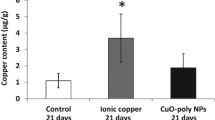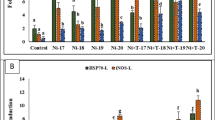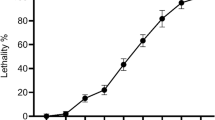Abstract
With the use of nanoparticles (NPs) in many industrial activities and consumer products, it is important to evaluate the effects of their release into the environment. Metal NPs (e.g., Ni-NPs or Cu-NPs) can release metal ions that are toxic to aquatic organisms; however, whether the toxicity is from metal ions rather than unique “nano-scale” effects of the NPs is unresolved. This research investigated Ni-NP toxicity in zebrafish Danio rerio larvae to clarify whether toxic effects are attributable to release of Ni ions. First, the acute (96-h lethal) toxicity of Ni-NPs was determined in comparison to aqueous Ni in fish exposed to Ni(II) by water-soluble NiCl2. Subsequently, sublethal experiments with Ni-NPs and Ni(II) were conducted to assess changes in expression of stress-related genes (mt2, rad51, and p53) by quantitative PCR. Acute toxicity of Ni in fish exposed to Ni(II) was higher (96-h LC50 = 32.6 mg/L) than for fish exposed to Ni-NPs (96-h LC50 = 122.2 mg/L). Also, DNA strand breaks were higher in Ni(II)- than Ni-NPs-exposed larvae. Induction of stress-related genes in larvae was complex and was not directly related to Ni-NPs and Ni(II) concentration, although there was a significant induction in the mt2 and p53 gene of the larvae exposed to Ni-NPs and Ni(II) relative to controls. Results indicated that while Ni-NPs induced gene expression (presumably by the release of Ni ions), the differences in concentration relationships of gene expression between Ni-NPs and Ni(II) suggest that factors in addition to the release of Ni ions from Ni-NPs influence acute toxicity of Ni-NPs.









Similar content being viewed by others
References
Ahamed M, Alhadlaq HA (2014) Nickel nanoparticle-induced dose-dependent cyto-genotoxicity in human breast carcinoma MCF-7 cells. Onco Targets Ther 7:269–280
Boran H, Ulutas G (2016) Genotoxic effects and gene expression changes in larval zebrafish after exposure to ZnCl2 and ZnO nanoparticles. Dis Aquat Org 117:205–214
Boyle D, Boran H, Atfield AJ, Henry TB (2015) Use of an exposure chamber to maintain aqueous phase nanoparticle dispersions for improved toxicity testing in fish. Environ Toxicol Chem 34:583–588
Buekers J, De Brouwere K, Lefebvre W, Willems H, Vandenbroele M, Van Sprang P, Eliat-Eliat M, Hicks K, Schlekat CE, Oller AR (2015) Assessment of human exposure to environmental sources of nickel in Europe: inhalation exposure. Sci Total Environ 521–522:359–371
Calatayud MP, Sanz B, Raffa V, Riggio C, Ibarra MR, Goya GF (2014) The effect of surface charge of functionalized Fe3O4 nanoparticles on protein adsorption and cell uptake. Biomaterials 35:6389–6399
Capdevila M, Bofill R, Palacios Ò, Atrian S (2012) State-of-the-art of metallothioneins at the beginning of the 21st century. Coord Chem Rev 256:46–62
Chan KM, Ku LL, Chan PCY, Cheuk WK (2006) Metallothionein gene expression in zebrafish embryo-larvae and ZFL cell-line exposed to heavy metal ions. Mar Environ Res 62:83–87
Chechik G, Koller D (2009) Timing of gene expression responses to environmental changes. J Comput Biol 16:279–290
Chiou YH, Wong RH, Chao MR, Chen CY, Liou SH, Lee H (2014) Nickel accumulation in lung tissues is associated with increased risk of p53 mutation in lung cancer patients. Environ Mol Mutagen 55:624–632
Cho YS, Lee SY, Kim KY, Nam YK (2009) Two metallothionein genes from mud loach Misgurnus mizolepis (Teleostei; Cypriniformes): gene structure, genomic organization, and mRNA expression analysis. Comp Biochem Physiol B Biochem Mol Biol 153:317–326
Choi JE, Kim S, Ahn JH, Youn P, Kang JS, Park K, Yi J, Ryu D-Y (2010) Induction of oxidative stress and apoptosis by silver nanoparticles in the liver of adult zebrafish. Aquat Toxicol 100:151–159
Chusuei CC, Wu C-H, Mallavarapu S, Hou FYS, Hsu C-M, Winiarz JG, Aronstam RS, Huang Y-W (2013) Cytotoxicity in the age of nano: the role of fourth period transition metal oxide nanoparticle physicochemical properties. Chem Biol Interact 206:319–326
Du Z, ZhangY Wang G, Peng J, Wang Z, Gao S (2016) TPhP exposure disturbs carbohydrate metabolism, lipid metabolism, and the DNA damage repair system in zebrafish liver. Sci Rep 6:21827
Garcia GJM, Schroeter JD, Kimbell JS (2015) Olfactory deposition of inhaled nanoparticles in humans. Inhal Toxicol 27:394–403
Griffitt RJ, Luo J, Gao J, Bonzongo J-C, Barber DS (2008) Effects of particle composition and species on toxicity of metallic nanomaterials in aquatic organisms. Environ Toxicol Chem 27:1972–1978
Horie M, Nishio K, Fujita K, Kato H, Nakamura A, Kinugasa S, Endoh S, Miyauchi A, Yamamoto K, Murayama H, Niki E, Iwahashi H, Yoshida Y, Nakanishi J (2009) Ultrafine NiO particles induce cytotoxicity in vitro by cellular uptake and subsequent Ni(II) release. Chem Res Toxicol 22:1415–1426
Horie M, Nishio K, Endoh S, Kato H, Fujita K, Miyauchi A, Nakamura A, Kinugasa S, Yamamoto K, Niki E, Yoshida Y, Iwahashi H (2013) Chromium(III) oxide nanoparticles induced remarkable oxidative stress and apoptosis on culture cells. Environ Toxicol 28:61–75
INSG Insight (2015) An overview of the nickel ındustry in Latin America. Newsletter, ıssue no. 26
Ispas C, Andreescu D, Patel A, Goia DV, Andreescu S, Wallace KN (2009) Toxicity and developmental defects of different sizes and shape nickel nanoparticles in zebrafish. Environ Sci Technol 43:6349–6356
Jiang J, Oberdörster G, Biswas PJ (2009) Characterization of size, surface charge, and agglomeration state of nanoparticle dispersions for toxicological studies. Nanopart Res 11:77–89
Ju-Nam Y, Lead JR (2008) Manufactured nanoparticles: an overview of their chemistry, interactions and potential environmental implications. Sci Total Environ 400:396–414
Kango S, Kalia S, Celli A, Njuguna J, Habibi Y, Kumar R (2013) Surface modification of inorganic nanoparticles for development of organic–inorganic nanocomposites—a review. Prog Polym Sci 38:1232–1261
Kanold JM, Wang J, Brümmer F, Siller L (2016) Metallic nickel nanoparticles and their effect on the embryonic development of the sea urchin Paracentrotus lividus. Environ Pollut 212:224–229
Kim SO, Kim YJ, Seo YR (2015) An overview of carcinogenic heavy metal: molecular toxicity mechanism and prevention. J Cancer Prev 20:232–240
Kimura T, Itoh N (2008) Function of metallothionein in gene expression and signal transduction: newly found protective role of metallothionein. J Health Sci 54:251–260
Kong L, Tang M, Zhang T, Wang D, Hu K, Lu W, Wei C, Liang G, Pu Y (2014) Nickel nanoparticles exposure and reproductive toxicity in healthy adult rats. Int J Mol Sci 15:21253–21269
Ling X-B, Wei H-W, Wang J, KongY-Q WuY-Y, Guo J-L, Li T-F, Li J-K (2016) Mammalian metallothionein-2A and oxidative stress. Int J Mol Sci 17:1483
Livak KJ, Schmittgen TD (2001) Analysis of relative gene expression data using realtime quantitative PCR and the 2∆∆C(T) method. Methods 25:402–408
Luo X, Morrin A, Killard AJ, Smyth MR (2006) Application of nanoparticles in electrochemical sensors and biosensors. Electroanalysis 18:319–326
Macirella R, Guardia A, Pellegrino D, Bernabò I, Tronci V, Ebbesson LOE, Sesti S, Tripepi S, Brunelli E (2016) Effects of two sublethal concentrations of mercury chloride on the morphology and metallothionein activity in the liver of zebrafish (Danio rerio). Int J Mol Sci 17:361
Magaye R, Zhao J (2012) Recent progress in studies of metallic nickel and nickelbased nanoparticles’ genotoxicity and carcinogenicity. Environ Toxicol Pharmacol 34:644–650
Mahoney S, Najera M, Bai Q, Burton EA, Veser G (2016) The developmental toxicity of complex silica-embedded nickel nanoparticles is determined by their physicochemical properties. PLoS ONE 11:1–20
Maurer-Jones MA, Gunsolus IL, Murphy CJ, Haynes CL (2013) Toxicity of engineered nanoparticles in the environment. Anal Chem 85:3036–3049
Minghetti M, Leaver MJ, George SG (2010) Multiple Cu-ATPase genes are differentially expressed and transcriptionally regulated by Cu exposure in sea bream, Sparus aurata. Aquat Toxicol 97:23–33
Mueller NC, Nowack B (2008) Exposure modelling of engineered nanoparticles in the environment. Environ Sci Technol 42:4447–4453
Örn S, Holbech H, Madsen TH, Norrgren L, Petersen GI (2003) Gonad development and vitellogenin production in zebrafish (Danio rerio) exposed to ethinylestradiol and methyltestosterone. Aquat Toxicol 65:397–411
Rao KV, Sunandana CS (2008) Effect of fuel to oxidizer ratio on the structure, micro structure and EPR of combustion synthesized NiO nanoparticles. J Nanosci Nanotechnol 8:4247–4253
Reinardy HC, Dharamshi J, Jha AN, Henry TB (2013) Changes in expression profiles of genes associated with DNA repair following induction of DNA damage in larval zebrafish Danio rerio. Mutagenesis 28:601–608
Schrand AM, Rahman MF, Hussain SM, Schlager JJ, Smith DA, Syed AF (2010) Metal-based nanoparticles and their toxicity assessment. Wiley Interdiscip Rev Nanomed Nanobiotechnol 2:544–568
Segner H, Caroll K, Fenske M, Janssen CR, Maack G, Pascoe D, Schäffers C, Vanderbergh GF, Watts M, Wenzel A (2003) Identification of endocrine-disrupting effects in aquatic vertebrates and invertebrates: report from the European IDEA project. Ecotoxicol Environ Saf 54:302–314
Stark WJ, Stoessel PR, Wohlleben W, Hafner A (2015) Industrial applications of nanoparticles. Chem Soc Rev 44:5793–5805
Vliegenthart AD, Tucker CS, Del PJ, Dear JW (2014) Zebrafish as model organisms for studying drug-induced liver injury. Br J Clin Pharmacol 78:1217–1227
Xiong D, Fang T, Yu L, Sima X, Zhu W (2011) Effects of nano-scale TiO2, ZnO and their bulk counterparts on zebrafish: acute toxicity, oxidative stress and oxidative damage. Sci Total Environ 409:1444–1452
Yeo MK, Pak SW (2008) Exposing zebrafish to silver nanoparticles during caudal fin regeneration disrupts caudal fin growth and p53 signaling. Mol Cell Toxicol 4:311–317
Yu LP, Fang T, Xiong DW, ZhuWT Sima XF (2011) Comparative toxicity of nano-ZnO and bulk ZnO suspensions to zebrafish and the effects of sedimentation, ·OH production and particle dissolution in distilled water. J Environ Monit 13:1975–1982
Zeinalov OA, Kombarova SP, Bagrov DV, Petrosyan MA, Tolibova GH, Feofanov AV, Shaitan KV (2016) About the influence of silver nanoparticles on living organisms physiology. Rev Clin Pharmacol Drug Ther 14:42–51
Zhao X, Ren X, Zhu R, Luo Z, Ren B (2016) Zinc oxide nanoparticles induce oxidative DNA damage and ROS-triggered mitochondria-mediated apoptosis in zebrafish embryos. Aquat Toxicol 180:56–70
Acknowledgements
This project was funded by Recep Tayyip Erdoğan University, Scientific Research Projects Fund (Project No: 2013.103.01.4). The information contained in this article was extracted from a doctorate thesis by the author, Savaş Şaffak.
Author information
Authors and Affiliations
Corresponding author
Ethics declarations
Conflict of interest
The authors declare no conflicts of interest in the present work.
Rights and permissions
About this article
Cite this article
Boran, H., Şaffak, S. Comparison of Dissolved Nickel and Nickel Nanoparticles Toxicity in Larval Zebrafish in Terms of Gene Expression and DNA Damage. Arch Environ Contam Toxicol 74, 193–202 (2018). https://doi.org/10.1007/s00244-017-0468-8
Received:
Accepted:
Published:
Issue Date:
DOI: https://doi.org/10.1007/s00244-017-0468-8




